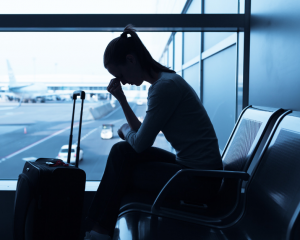 Experts estimate over 80% of the population will experience a back injury at some point. Over half of all working Americans admit to having back pain symptoms each year. This problem is a growing issue in today’s society. One of the main culprits is the increase in sedentary lifestyles.
Experts estimate over 80% of the population will experience a back injury at some point. Over half of all working Americans admit to having back pain symptoms each year. This problem is a growing issue in today’s society. One of the main culprits is the increase in sedentary lifestyles.
Spinal injuries are most commonly attributed to mechanical issues arising from the spine’s joints, ligaments, muscles, and nerves. Being hyper-aware of the day-to-day habits that impact your back can keep you ahead of the pain.
A common habit that we get asked about all of the time is airplane travel. Over 8 million people fly every day. Getting through security, navigating the airport, and long flights on an uncomfortably small chair can all put immense stress on the body. Whether you’re dealing with chronic or acute back pain, or maybe none at all, flying smart can help avoid later complications. Read below for some essential ideas and tips to remember the next time you prepare for take-off.
Plan Ahead:
- Book flights at off-peak times to avoid overly crowded flights. Book flights with shorter in-flight connections or layover times when applicable.
- Always book an aisle seat when given the option to choose your seat. These allow you to quickly get up and move around the cabin during flight.
- Remember: specific rows on planes do not recline. These are often the very last row and the row directly in front of the exit row.
- Invest in lightweight spinner luggage. This form of luggage has the benefit of being the easiest to glide across airport floors.
- Pack light. Heavy bags can cause or aggravate back pain by straining muscles and joints of the spine.
Boarding:
- Be aware of your surroundings. Most of us are not used to being packed into a small, tight space with little room to move. Focus on proper mechanics with every movement.
- Lift luggage in stages. Back injuries are most commonly caused by over-exerting when lifting a heavy item. First, lift your luggage onto the top of a seat. Then, in a separate motion, lift it into the overhead bin. Reverse the process when removing the bags at the end of your flight.
- Lift by squatting and bending at the knees for a lift. Always lift with the legs and avoid hyperflexion of the lower back.
- Minimize twisting of the torso while lifting. Instead, pivot with the feet.
Taking Your Seat:
- Carefully lower yourself into the seat with a “tall spine.” Position yourself back in your chair, bending at the hips to lower yourself.
- Keep your shoulders back and avoid slouching or hunching forward. Keep your feet firmly resting on the floor or a footrest if needed.
- Bring a travel pillow for rest and reading time to avoid neck strain.
- For lower back pain, use a lumbar support pillow to prevent slouching. Self-inflating lumbar supports are great because they can quickly become flat for easy packing.
- No pillow? Ask a flight attendant for one, or use a rolled-up jacket, sweater, or blanket to provide support behind your lower back.
- Fasten the lap belt over the hip bones. This will secure your body in an ideal posture for flying. It prevents too much extension or flexion. Never place the lap belt above or on your belly.
During The Flight:
- Get up and move as much as possible! Sitting in one position for long periods can stiffen the back muscles and stress the spine. These combine to make back pain worse. You should get up at least every 30-45 minutes, especially during longer flights.
- While standing, make sure to loosen up those joints and muscles that have been inactive. Go to the back of the plane and do some gentle stretches. Movement stimulates circulation, allowing blood to bring necessary nutrients and oxygen to the structures of the back and legs.
Simple stretches and exercises to do during the flight:
- Seated push-offs: from a seated position, create fists and use them to push your body off the seat to a slight raise. Engage your core and round head into the chest. A stretch should be felt across the back muscles.
- Figure 4 Stretch: Cross one leg over the top of the knee of the other leg from a seated position to create a “figure four” position. Lean your body towards your legs to build tension in your glutes and piriformis muscles until you feel a stretch. Hold this stretch for 20 seconds, repeating three times for each leg.
- Sitting hamstring stretch: Sit at the edge of your seat with one leg straightened in front and your heel on the floor. Have your torso tall and straight, then try pushing your navel towards the thigh while keeping the back arched without leaning the body’s trunk forward. Hold this stretch for 20 seconds, repeating three times for each leg.
- Air circles: gently create circular movement in the shoulders, wrists, and ankles; perform this from a seated or standing position.
Airplane travel with back pain can be difficult, but it mustn’t be debilitating. Whether seeking relief from chronic pain or simply aiming for optimal health, your Livonia chiropractor guides you every step of the way. Contact our office to schedule an appointment by Clicking Here or giving us a call today: 734-427-6333

